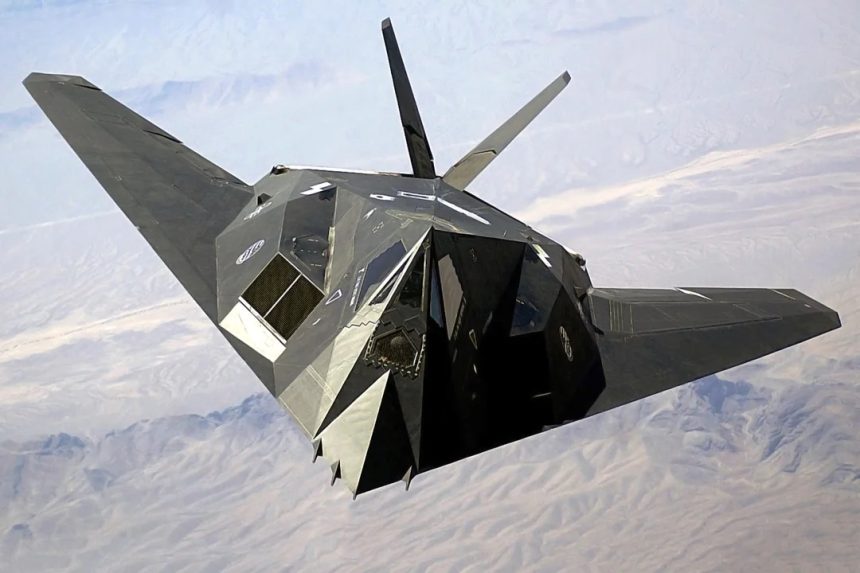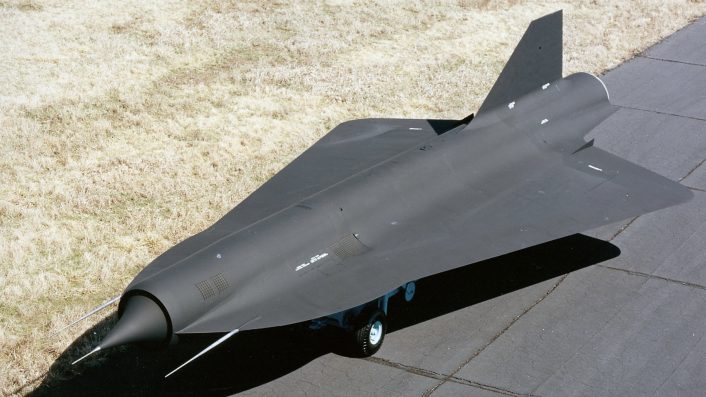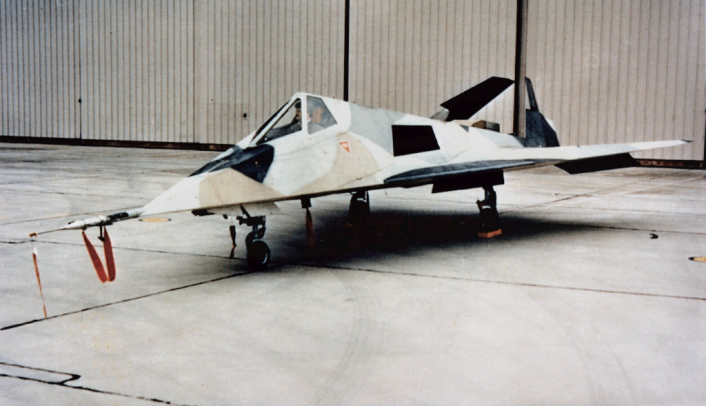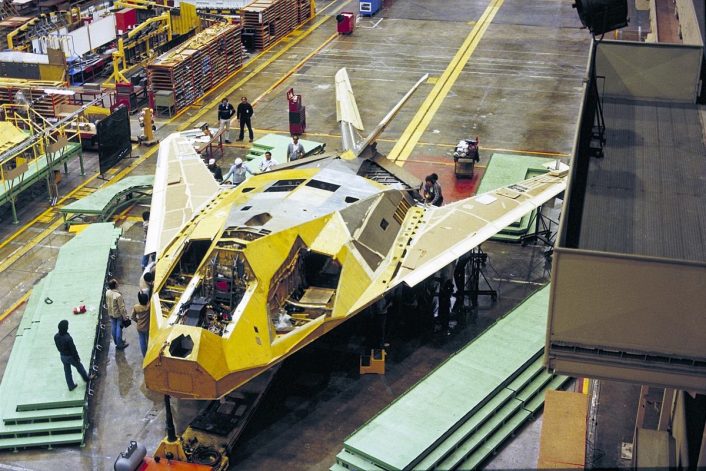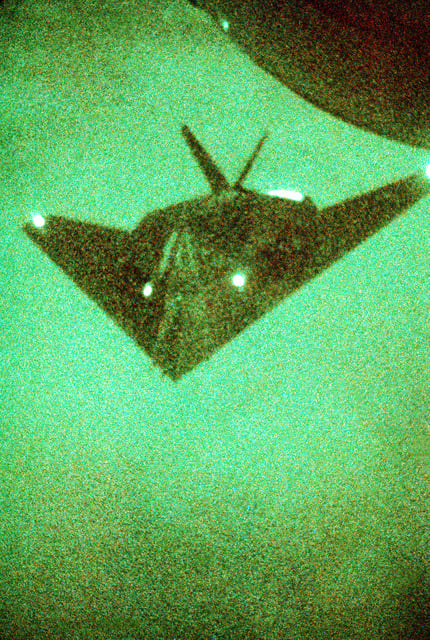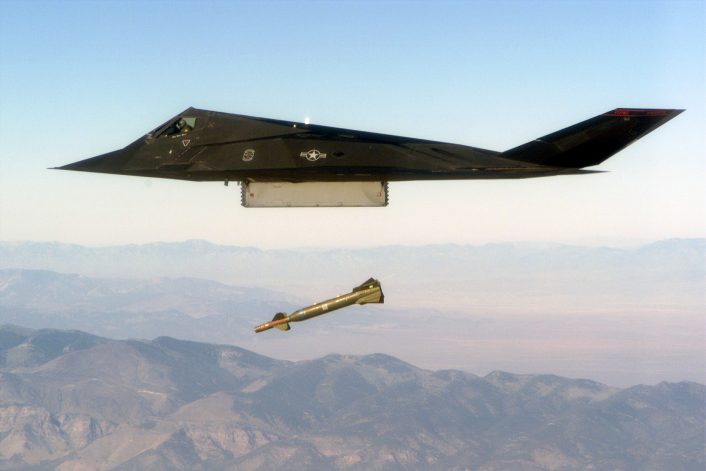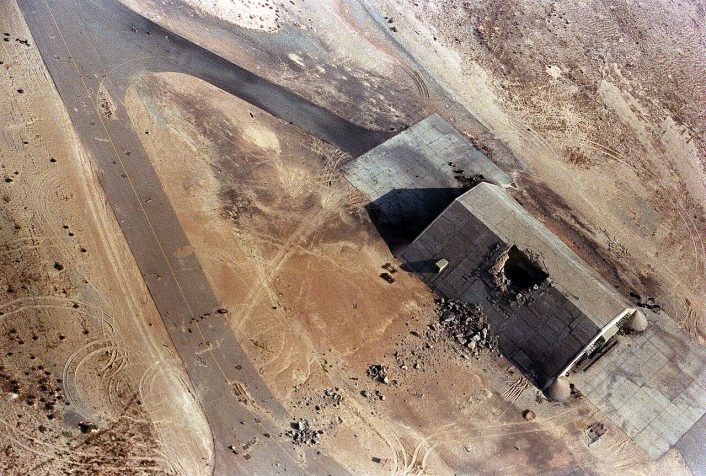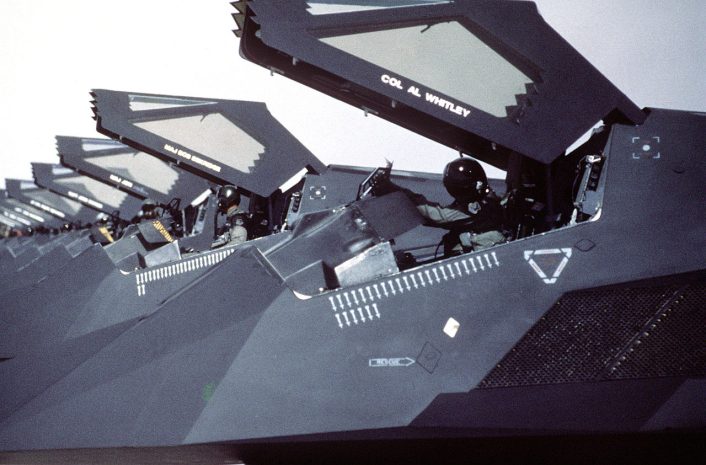Although the F-117 Nighthawk first saw action during operations over Panama, the aircraft impressively demonstrated its capabilities during the initial air campaign over Baghdad, Iraq.
Making coalition first strikes on high priority targets with precision in the opening hours of the air campaign during Operation Desert Storm, Lockheed’s ‘Stealth Fighter’ had proven invaluable in a highly defended air space. F-117s hit command and control facilities, air defenses, communication targets, bunkers, hangers, and other targets to limit the enemy’s ability to control forces and mount resistance. Many targets were hardened against aerial attacks, but were destroyed regardless by the Nighthawk.
Hopeless Diamonds and Have Blues
The F-117 is a product of the famed Lockheed Advanced Development Projects (ADP), or better known as ‘Skunk Works’, in Burbank, California. Skunk Works was at the time headed by Benjamin ‘Ben’ Robert Rich with the retirement of Clarence ‘Kelly’ Johnson.
A highly classified and serious study undertaken by the Defense Advanced Research Projects Agency (DARPA) of Low Observables (LO) technology in 1974 included McDonnell Douglas, Northrop, and others — Lockheed was not included and was unaware of the study. During this study, DARPA had requested proposals from several aerospace companies.
However, Ben Rich became aware of the study and had Lockheed working on LO technology without a government contract when Skunk Works mathematician Denys Overholser handed Rich a drawing of an arrowhead shaped aircraft on May 5, 1975. Designed as a three-dimensional aircraft made of multiple flat panels, resembling the cutting of a diamond into slices, Overholser referred to the plane as ‘The Hopeless Diamond.’
Using software utilizing the elements of the studies of Pyotr Ufimtsev, a Soviet engineer and leading expert on radar, the Hopeless Diamond was designed utilizing faceted angles instead of smooth blended shapes. Coupled with Radar Absorbent Materials (RAM), this should make the aircraft a difficult target for radar. Ufimtsev’s Method of Edge Waves in the Physical Theory of Diffraction was largely dismissed by the Soviets, but would lead to the procurement of stealth technology by the United States.
Overholser explained to Rich the aircraft would have a the smallest radar cross section of anything Skunk Works has produced, including the D-21 drone, as the signature of the model was about the size of a golf ball when tested in March 1976 at White Sands, New Mexico. As a result of the tests at White Sands, Lockheed and Northrop were asked to continue with their work.
Lockheed would build two experimental aircraft under a project known as Have Blue. The aircraft were sharply angular with flat surfaces. The arrowhead shaped aircraft were 47 ft 3 in long and 7 ft 6.25 in height. Wingspan was 22 ft 6 in with a sweep of 75.5 degrees.
Power was provided by a pair of General Electric J85-GE-4A turbojets with no afterburner, this coupled with subsonic speeds reduced the heat signature of the plane. A steel tool cabinet in the shop became the donor for makeshift heat shield panels when engine test runs indicated an overheating problem near the tail. The engines were removed, the tool cabinet cut up and made into heat shields, working to Skunk Works perfection.
During testing of the Have Blue aircraft, it was discovered that its surfaces had to be absolutely smooth and seams and joints must fit perfectly to obtain the desired stealth results. At one point the test plane lost its stealth abilities, being detected at 50 miles out. It was determined three screws were not completely tightened, extending above the aircraft surface less than an eighth of an inch making the plane the size of a barn door on radar.
Although both of the single-seat Have Blue aircraft would be lost in testing, several flights were completed and they did fly against the most sophisticated radars and proving the concept and impressing the United States Air Force (USAF). This lead to orders for a larger operational production aircraft under a program known as Senior Trend and designated the F-117A.
Nighthawks
Under the Senior Trend program the USAF ordered five full-scale developmental airframes and 20 operational aircraft in November 1978. The first aircraft was delivered on Jan. 16, 1981 and made its first flight on June 18 of that year. The first five test aircraft were known by the designation YF-117, with the total 59 production aircraft designated F-117A and given the name ‘Nighthawk’.
The new aircraft was much larger than the Have Blue types, with a length of 65 ft 11 in, wingspan of 43 ft 4 in, and height of 12 ft 9.5 in. Differences in configuration included the sweep of the wings was now 67.5 degrees, and the inward canted tails of the Have Blue aircraft was now redesigned as a ‘V’ tail. Covered in RAM the F-117 weighted in at 30,000 lbs empty.
The F-117A derives its power from two General Electric F404-GE-F1D2 turbofan non-afterburning engines rated at 10,800 lbs thrust each. Engine intakes as well as exhaust ducts are unconventional with composite grids coated in RAM covering the intakes to reduce radar signatures of the whirling turbine blades, and the exhaust ducts narrow from a circular section to a narrow slot at the trailing edge of the of the fuselage, reducing heat signature along with reduced noise. Maximum speed for the single-seat aircraft is Mach 0.92.
Although often referred to as the ‘Stealth Fighter’, the F-117 carried no air-to-air weapons – even though this topic is highly debated.
The long-standing debate about whether the F-117 Nighthawk ever had an air-to-air role resurfaced in 2020, after a revealing interview on the Fighter Pilot Podcast. In that episode, still available online, a former F-117 pilot explained that although the jet’s primary role was attack, it was technically capable of carrying almost every munition in the inventory at the time of its introduction, including some air-to-air weapons. He went as far as to state that the “secondary role was to shoot down Soviet AWACS,” exploiting the stealth jet’s ability to slip through radar coverage and target high-value assets.
His words seemed unequivocal and left little room for interpretation, especially when he described crews joking about adding a Soviet AWACS kill marking on their aircraft. However, months later, after his comments had gained attention, the same pilot told The War Zone that “the Nighthawk never actually had air-to-air combat as an operational mission,” effectively walking back the earlier claims.
The apparent contradiction is puzzling, given the pilot’s firsthand experience and the fact that his original remarks can be heard on the podcast. Whether it was a matter of semantics, classification, or a change of heart, the discrepancy continues to fuel speculation about the Nighthawk’s true capabilities.
Instead, being a platform for dropping precision guided munitions on ground targets, the Nighthawk was fitted with two internal weapons bays capable of housing the GBU-10 Paveway II laser-guided bombs , GBU-12 Paveway II laser-guided bombs, GBU-27 Paveway III laser-guided bombs, GBU-31 JDAM INS/GPS guided munitions. According to some sources, it could also carry AGM-88 HARM anti-radiation missiles, AGM-65 Maverick air-to-surface missiles, and even the B61 nuclear bomb, although separating reality from fiction when it deals with the payload of the Nighthawk, as mentioned, is difficult. The F-117 was a nocturnal ground attack aircraft with no radio, radar, lights, or any electronic devices that could be detected by air defense networks.
Deployed
December 1989 saw the first combat operations by the F-117 during Operation Just Cause and the United States involvement in Panama. Six Nighthawks flew from their secretive base at Tonopah Test Range Airport, Nevada to Panama. A pair of F-117’s dropped bombs on Rio Hato airfield. Panamanian radar was woefully inadequate to begin with, so the Nighthawk would have to wait for a better opportunity to make an impression. That opportunity would come soon over one of the most heavily defended cities in the world.
Six short months after Operation Just Cause, three squadrons of F-117s from the 37th Tactical Fighter Wing (TFW) found themselves on their first overseas deployment, at Khamis Mushayt, Saudi Arabia. Iraqi forces under Saddam Hussein had invaded the tiny neighboring country of Kuwait in August of 1990, and Operation Desert Shield was a buildup in the region in response by a coalition of forces. More F-117s would follow.
The first 22 Nighthawks flew to Langley Air Force Base (AFB), Virginia, on Aug. 19, and then on to Saudi Arabia, and belonged to the 415th Tactical Fighter Squadron (TFS) also known as the ‘Nightstalkers’, with 18 more aircraft arriving from the 416th TFS, the ‘Ghostriders’. A small number of F-117s arrived later from the 417th Tactical Fighter Training Squadron (TFTS). Khamis Mushayt became known as ‘Tonopah East’ due to the similar desert climate and abundance of F-117s. Several months of preparation and war gaming would prepare the crews and aircraft for the dangerous missions to come.
Baghdad, Iraq was heavily defended with some of the most advanced radar systems, Surface-to-Air Missile (SAM) systems, and anti-aircraft defenses on earth. Initial aircraft losses, even those involving the F-117, were predicted to be high. Baghdad was also the hub of the Iraqi war machine with several high priority targets that needed neutralized in the early hours of the coming war.
Going Downtown Baghdad
In the hours of darkness of the morning of Jan. 17, 1991, explosions began to rock the Baghdad area, as the air campaign began and Operation Desert Shield became Operation Desert Storm. Iraqi air defenses, blind and confused, began sweeping the skies with random undirected anti-aircraft fire, producing some of the most spectacular footage of the war for television newscasts, but not finding any aerial targets. The Iraqis knew the planes were there, but their radar was not tracking them. The manned aircraft over Baghdad were F-117s of the 37th TFW and Lockheed’s stealth technology was working to perfection.
These were not the first bombs dropped in Iraq by an F-117 however. USAF Major Gregory Feest and nine other Nighthawk pilots would lift off from Khamis Mushayt at precisely timed intervals for assigned targets. Maj. Feest’s first target was far to the southwest of Baghdad. In conjunction with Army and Air Force helicopters, F-117s were to open a gap in Iraqi air defenses to make way for other airstrikes. Moments after the helicopters struck their targets, Maj. Feest dropped the first bomb of the war, a laser-guided 2,000 lb GBU-27, hitting a hardened Iraqi Air Force Radar Intercept Operations Center. Continuing his mission, he flew through air space saturated with flak and tracers, dropping his second bomb and like the others, returned safely. Maj. Feest also has the distinction of dropping the first bombs in Operation Just Cause earlier. He would continue to fly 39 combat missions during Operation Desert Storm.
During the first night of bombing, over 1,000 sorties were flown against targets in Kuwait and Iraq. High priority targets included the headquarters of the Iraqi Air Force, power stations, communication, infrastructure, missile and ammunition bunkers and storage facilities, command and control facilities, Iraqi air defense facilities, SCUD missile bunkers, and other facilities and resources that would facilitate retaliatory actions by the Iraqi military. Approximately sixty 2,000 lb precision guided bombs were dropped in the darkness of early morning January 17 by F-117s on these targets.
Video of the precision strikes was released to the media, and the world watched in awe as targets were obliterated before their eyes on news outlets. One attack showed a curser locked on a main air duct of a SCUD missile facility. The duct, approximately one meter in diameter, would soon receive a 2,000 lb laser-guided bomb resulting in a devastating explosion filling the screen.
Other spectacular examples of video footage of the F-117s effectiveness included the destruction of the Iraqi high-priority targets such as communication centers in and around Baghdad. Leaflets were dropped on Iraqi troops showing F-117 hitting ground targets and encouraging them to surrender or flee. F-117s were also used to target airfields and hardened hangers along with other facilities.
The GBU-27s were laser-guided and could penetrate several feet of concrete, making them excellent choices for hardened targets. At one point, so many GBU-27s had been dropped, a shortage occurred. So the Air Force switched to the lighter GBU-10s. One Iraqi air base labeled H2 was attacked with the lighter bombs, which bounced off the roofs of hardened aircraft hangers. The Iraqis thinking they had finally won at something crammed the hangers full of aircraft, only to have the F-117s return a few nights later with GBU-27s and obliterate all the aircraft jammed into the hardened hangers.
Colonel Barry Horne reported while deployed with F-117s in Saudi Arabia that visual evidence stealth technology worked was provided by dead bats. The bats would feed at night on insects around the aircraft, and being guided by a form of sonar; the bats would not ‘see’ the aircraft and collide with them, killing themselves. His belief in the technology was reinforced when on the first night piloting the F-117 on a mission over Baghdad carrying two GBU-27s, he detected French-built Iraqi Mirage F-1s and Soviet-built MiG-29s in the skies around him, but the Iraqi planes apparently never saw the Nighthawks.
Major Miles Pound suffered a jammed weapons bay door after dropping his bombs from his F-117 over Iraq. Open weapons bay doors or landing gear doors lit the planes up on enemy radar. Maj. Pound knew he had been detected and then saw a SAM rising towards him. Fighting to manually close the stuck-open door with one hand and the other hand gripping the eject lever, the door finally shut with the missile closing in. Once the door was closed, the missile lost its homing and turned away from the aircraft.
As the air campaign progressed, the F-117 would be used to attack other targets such as airfields and bridges, with the type being responsible for the destruction of 39 of the 43 bridges over the Tigris-Euphrates River.
During Operation Desert Storm, also known as the Gulf War, the F-117 flew approximately 1,300 sorties in 6,900 hours and hit 1,600 high-value targets. 42 Nighthawks dropped 2,077 bombs during the campaign, mostly GBU-10s and GBU-27s. Despite predictions to the contrary at the outset of the war, no F-117s were lost, and the aircraft would continue on to fight in other conflicts. The ‘Black Jet’ or ‘Stealth Fighter’ and its deadly cargo of ‘smart bombs’ operating with seeming impunity over enemy territory had become the symbol of American power and ingenuity. And it all began with a single idea using technology ignored by the Soviets and a ‘Hopeless Diamond’ — from the company that wasn’t even invited to the party.

